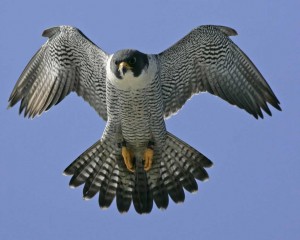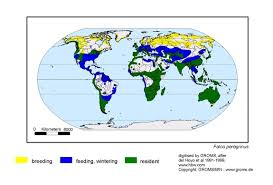Michael Garcia
Jeremy Middleman
Biology 105: Singing Life of Birds
Peregrine Falcon
Blog Post #1
The Peregrine Falcon is a large Falcon that is the largest Falcon over most of North and South America. Characteristics to identify the bird are it’s long pointed wings and long tail. Like many other birds the color of the bird changes from its juvenile years to its adult years. During its juvenile years the falcon contains vertical streaks across its chest but during its adult years the falcon contains horizontal bars on its chest. Overall, the falcon is blue and gray with a dark head. (allaboutbirds.org)
Though they can be found throughout the United States and Mexico all year round they are most often found along the coasts. They can also be found hunting in large open areas and nesting in cliffs. Much like other birds, the Peregrine Falcon migrates during the winter months, the non-breeding season, and can be found along the southern coasts of the United States and Mexico as well as most of South America. Due to their migration from North America and South America they be spotted in Central America and the Caribbean during their migration. Once winter is over they migrate back to North America to begin the breeding season. (allaboutbirds.org)
The Peregrine Falcon is the world’s fastest bird being able to reach speeds up to 200 mph when diving in the air to catch its prey. Their normal cruising speed is between 24 mph and 33 mph. When pursuing prey they increase their speed to 67 mph. Due to their fast flying abilities and great strength the Peregrine falcon hunts for its prey in large open areas where the open space allows it to catch its prey with ease. Its main diet is composed of other birds. In fact, there are up to 2,000 documented species that are prey to the peregrine falcon. Peregrine falcons feed chiefly on avian prey, including shorebirds, pigeons, blackbirds, jays and other medium-sized birds. Their prey may range in size from small songbirds to large ducks. They kill prey primarily by striking them with partially-closed talons from above and catching them in mid-air as they fall. These high-speed strikes take the form of free-fall dives called “stoops”.They are also known to hunt a great variety of birds and different sizes. Their prey can be as large as the Sandhill Crane and as small as the hummingbird. Their diet is not entirely composed of other birds as they also hunt for bats, rodents, and fish. (allaboutbirds.org)
When hunting for its prey, the Peregrine Falcon will begin by soaring at great altitudes to search for its prey from above. After spotting its prey, it will dive down and grab its prey or strike it hard enough to stun or kill its prey with its feet. Though this is their primary hunting method they also utilize other hunting methods like level pursuit. (allaboutbirds.org)
Though the Falcon may be a very elite hunter it is also susceptible to its own predators like eagles and other falcons. (allaboutbirds.org)
Peregrines have many form of communication. One common behavior is the use of calls. Calls are used display their territory, communicate to other falcons, and in defending their territory and food. In the morning Peregrines often sing duets before sunrise to display their territory. Amongst the females their is a unique behavior in that females will utilize vocalization to beg for food. The falcons calls are simple calls that are often characterized by its monosyllabic sound that sounds like squaks. (animaldiversity.org)
Other forms of communication include elaborate flight displays, plumage patterns, and changing the color of the skin on its face from orange to yellow. (animaldiversity.org)
Peregrines exhibit many social behaviors in the act of mating. One common behavior is bowing. This is a general display which many males use in attracting a mate. Both males and females will show a ledge display. This occurs when the falcon performs multiple courting actions such as leaning over the nest, bowing, and ee-chupping. When the male performs the ledge display, it will stare the female in the eyes. Both birds also engage in scraping. In this behavior, the falcon rubs its chest down along an area where a potential nest could be made. It pushes its legs out behind it. Sometimes, both birds show a ledge display at the same time. One will present a ledge display and the other one will join in. Scraping occurs in multiple places before one ledge is chosen for eggs. One common behavior for males is to offer food to females. If the female accepts the food, she invites the male to approach closer to the nesting area and to become the female’s mate. Some males also exhibit landing displays or postures in which they prance around while appearing to shrug. A common female mating posture is copulation in which the female leans forward or moves her tail to one side. This is done if the female is attracted to the male. (Hinterland Who’s Who)
Peregrine falcons tend to place nests in high places. Often, mates will return to the same nest year after year. The female lays 3-5 eggs at 48-72 hour intervals and both the male and female incubate them. Only one of those eggs will be raised by the pair however. The parents will brood the hatchling for up to 20 days. Age of first breeding ranges from 1-8 years, typically occurring at 2-3 years. Females often breed a year before males. Peregrines live up to 20 years in the wild. (Virginia Department of Game and Inland Fisheries)
Habitat Nesting, the construction of nests, of peregrines in Virginia typically begins in March following a period of courtship. Peregrines have historically nested on the ledges of natural cliff faces in western Virginia. Although this mountain population is beginning to stage a comeback, the majority of peregrines currently nest in the Coastal Plain on artificial structures such as specially-constructed towers, nest boxes, bridges and tall buildings. The nest consists of a depression scraped in substrate such as dirt, sand, fine gravel, or debris. The falcons show considerable attachment to one nest location, and may return to it in successive years. The female lays 3-5 eggs at 48-72 hr intervals, and both the male and the female incubate them. Peregrines will raise only one brood per season, but may renest within a season if the eggs are lost during incubation. Incubation lasts 33-35 days. Chicks generally hatch within 24-48 hrs of one another. Young hatch covered in down and with their eyes closed. Within 5 days of hatching their mass has doubled, and they are almost fully feathered within 40 days. During this time they are cared for by the parents, who will brood them for up to 20 days and feed them. Chicks begin to fly when 40-45 days old. Although their first flight from the nest may be weak, the young are able to pursue adults to solicit food within 10 days. Young peregrines acquire adult plumage in their third year. Age of first breeding is variable, ranging from 1-8 years, but typically occurs at 2-3 years. Females tend to breed one year earlier than males. Peregrines may live 16-20 years in the wild. However it is also a very widespread bird because it can be found in all continents. (allaboutbirds.org)
As previously noted, peregrines are the world’s fastest bird. They have numerous biological mechanisms that allow them to travel so fast, but their wing aerodynamics – the methods for reaching such high speeds and controlling their direction – have not been thoroughly investigated. To analyze how these birds achieve such high speeds and control during predation, further research could attempt to model their descent. In an experiment, one could attach cameras to the falcon to see how it balances in midair.
Bibliography
Peregrine Falcon. (n.d). Retrieved May 4, 2015, from http://www.allaboutbirds.org/guide/
Peregrine Falcon. (n.d). Retrieved May 4, 2015, from http://www.hww.ca/hww2.asp?id=60
Breeding. (n.d) Retrieved May 4, 2015, from
http://www.virginia.gov/birds/peregrine-falcon/breeding.asp
Kirschbaum, K. (2004, November 5). Falconidae Falcons. Retrieved May 4, 2015, from http://animaldiversity.org/accounts/Falconidae/



what kind of birds do you know? i think you really love a bird